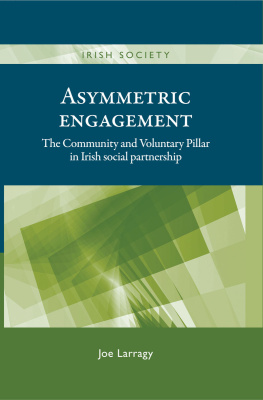Networking and Community Partnership
To Rachel and Phillip
First published 1999 by Ashgate Publishing
Reissued 2018 by Routledge
2 Park Square, Milton Park, Abingdon, Oxon OX14 4RN
711 Third Avenue, New York, NY 10017, USA
Routledge is an imprint of the Taylor & Francis Group, an informa business
Copyright Steve Trevillion 1999
All rights reserved. No part of this book may be reprinted or reproduced or utilised in any form or by any electronic, mechanical, or other means, now known or hereafter invented, including photocopying and recording, or in any information storage or retrieval system, without permission in writing from the publishers.
Notice:
Product or corporate names may be trademarks or registered trademarks, and are used only for identification and explanation without intent to infringe.
Publishers Note
The publisher has gone to great lengths to ensure the quality of this reprint but points out that some imperfections in the original copies may be apparent.
Disclaimer
The publisher has made every effort to trace copyright holders and welcomes correspondence from those they have been unable to contact.
A Library of Congress record exists under LC control number: 98052025
Typeset by Mantn Typesetters, 5-7 Eastfield Road, Louth, Lines, LN11 7AJ, UK.
ISBN 13: 978-1-138-33374-1 (hbk)
ISBN 13: 978-1-138-33376-5 (pbk)
ISBN 13: 978-0-429-44579-8 (ebk)
I would like to thank all those who took part in the research projects on which this book is based, including all the professionals, carers and service users who contributed to the West London Project, the social workers who took part in the North London Project, Elisabeth Weibahr and the other kuraors at Danderyds Sjukhus who contributed so much to the Swedish Project, my colleagues Peter Beresford, Naseem Shah and Betula Nelson and my former colleagues Kirsty Woodward and David Green.
My renewed thanks are also due to all those who contributed to the first edition of this book, especially Andy Brown, Suneel Chadha, Clive Turner, Justine Pepperell and Alison Partridge.
Finally, I would like to thank Maurice Kogan and Linda Thomas for their help and support in the writing and rewriting of this book and all those who enabled me to focus on this work at a very difficult time in my own life.
The first edition of this book was published in 1992 as Caring in the Community: a networking approach to community partnership . This edition has been thoroughly revised and rewritten in the light of recent research. The new title reflects a stronger emphasis on the concept of networking than was present in the initial text and the overall aims and objectives are:
- to develop a general theory of networking,
- to define the practice components of networking,
- to explore specific networking tasks and roles,
- to analyse the impact of networking on particular fields of social welfare practice, and
- to identify key issues for teaching and learning about networking.
The book has been written for a mixed readership and the hope is that welfare practitioners and their managers will find as much of value in it as students, academics and policy makers. The author is a former social worker but networking is an interdisciplinary field and what has been written is not just for social workers but also for community workers, health promoters, community psychiatric nurses and anyone else interested in networks and networking.
The term networking has become almost as familiar to social services practitioners, managers and policy makers in the 1990s as the term genericism was to the post-Seebohm generation in the 1970s. Thirty years ago, genericism was closely associated with the idea of a unified social services department: a large publicly owned and controlled organisation with a single director, directly accountable to local politicians and aiming to offer access through one door to a wide range of in-house services for individuals and families needing help (Seebohm Committee, 1968). In contrast, networking is closely associated with the development of a very different vision of social welfare.
In the 1990s, it is no longer assumed that social services departments can meet need through the provision of a relatively standardised set of services. Instead, the solution to individual and family problems is increasingly seen as dependent on the linking together of a wide range of different kinds of organisations - private, public and voluntary - each providing some specialist contribution and the whole requiring coordination and strategic alliances rather than traditional management and administration. The term virtual organisation has been coined to describe some of the more radical attempts to build new kinds of welfare structures betwixt and between conventional welfare institutions (Statham, 1996, p.10).
A number of specific changes have encouraged this trend. These include the National Health Service and Community Care Act (1990), especially perhaps the introduction of care management with its emphasis on the coordination of complex care packages and joint commissioning based on the idea of a strategic partnership between health and social services (McBrien, 1996), the new emphasis on primary care teams (Jones, 1992) and the introduction of health and education action zones (Peck and Poxton, 1998). Some of these changes have been driven forward by governments committed to market ideologies and various versions of communitarianism (Etzioni, 1995); some have been generated by grassroots social movements (Brandon, 1995).
All of these developments have been accompanied by endless calls for those involved with assessing need and planning or delivering services, whether for communities as a whole or for specific individuals, to network with one another outside conventional organisational structures and systems so as to develop new types of partnership transcending sectoral boundaries and linking planners, purchasers, providers and users of services with one another and with communities as a whole. So closely identified has networking become with this broad vision of partnership that it is impossible to discuss it in isolation from the emergence of that vision.
While the partnership concept was originally used in a limited way to indicate that clients are fellow citizens (British Association of Social Workers, 1980) and therefore entitled to be treated with respect by professional social workers, in recent years it has become identified with the much bigger idea that social services themselves should be seen as a product of a wide-ranging social partnership (Etzioni, 1995; Hutton, 1997). As a result, what was once identified with particular areas of social policy such as child care and community care now seems to have permeated the fabric of policy making in local as well as central government. To take just one example of this, the London Borough of Croydon has described its anti-poverty strategy as one which is explicitly based on the partnership principle: To improve the quality of life and opportunities for groups and individuals across the Borough by working in partnership with other public bodies, the private sector, voluntary organisations, community groups and other agencies (Croydon Strategic Projects, 1997).
This is not a purely local or national phenomenon. Within the broader European context, the New Community Partnership designed to embrace local people, local government and local business in an integrated fashion (Macfarlane and Laville, 1992) is but one of the attempts currently being made to revive civil society and social solidarity in the European Union. But unless something is done to enable these ever more ambitious partnership structures to fulfil their promises of mutual understanding and joint decision making, there is a danger that the sheer complexity of roles, tasks and relationships characteristic of the new welfare partnerships, already exacerbated by the impact of globalisation and deregulation (Trevillion, 1996a, p.100), may lead only to higher levels of confusion, poorer decisions and a downward spiral in the level of service quality. It is here, where vision and rhetoric have to be translated into practice, that networking can be located. However, networking, like partnership, is not immune to the dangers of inflated expectations and so it is important to establish a reliable definition before going any further.









